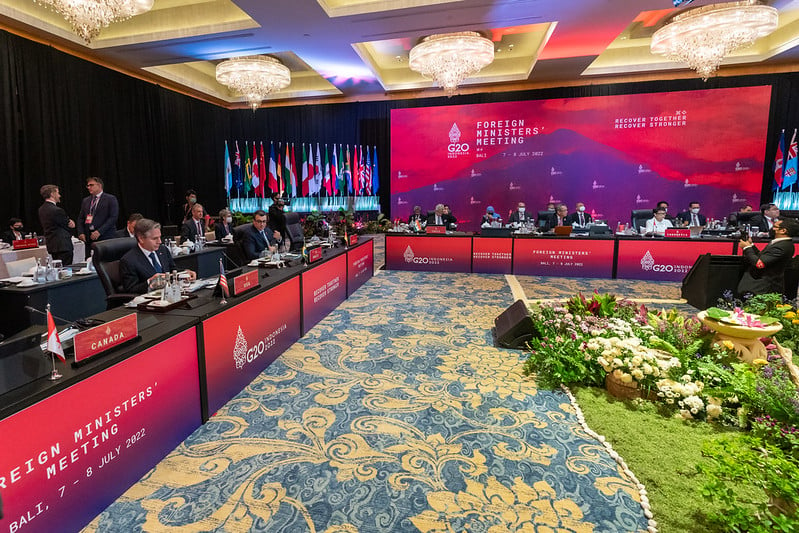Several events this year – from the June 2023 Paris financing pact summit to the September 2023 Africa Climate Summit and October’s IMF and World Bank annual meetings – have been billed as aiming to deliver debt relief for low- and middle-income countries, especially in Africa.
The institution that has been at the centre of this for the last three years is the Common Framework for Debt Treatment beyond the Debt Service Suspension Initiative (DSSI). It was set up in 2020 by the Group of 20, or G20, an international forum including most of the world’s largest economies, membership of which expanded to 21 with the inclusion of the African Union in September.
The avowed purpose of the Common Framework was to “facilitate timely and orderly debt treatment” for countries eligible for the DSSI, which had allowed suspension of debt repayments in the wake of Covid-19 but did nothing to address long-term debt problems.
The scheme was modelled on the Paris Club, an informal group of official creditors comprised in large part by former colonial powers. Importantly, the Paris Club was designed so that the borrower is not in the room for the deliberations or final decision on relief. The club still doesn’t allow the borrower at the table, but other creditors such as China and India – and the multilaterals, the IMF and World Bank – do join in.
The rationale for this design is similar to that of early forms of European bankruptcy law in the 1500s. The concern then, and for the wealthy Paris Club creditors in the current epoch, was with what economists call “moral hazard”. This is the idea that if you let people, firms or even countries get debt relief easily, they’ll just spend again, and badly.
This theory is significant because it tends to lead to a very conservative approach to debt relief, and it now permeates the Common Framework. However, the theory is also incredibly outdated, and explains why the framework has failed so far.
The case of Zambia
Zambia’s experience illustrates this. Having defaulted on a bond payment in November 2020 and applied for relief under the Common Framework, and after months of no movement as creditors wrangled between themselves over issues such as fair burden sharing, in March 2023 Zambian Treasury and Central Bank representatives took the initiative to visit China on their own.
They worked out a plan for restructuring with Chinese banks, based also on their experience of having successfully negotiated over $200m of relief with China in the past, all on their own. Zambia then presented the result to the Paris Club, who agreed to similar terms.
Now, Paris Club lenders could potentially have done more, but Zambia will never know. And although Zambia would logically welcome further relief from itsT multilateral and private sector lenders, none of that has yet happened, although the country did get debt relief from multilaterals around 20 years ago.
The upshot is that borrowers like Zambia are losing from this system. But this should not be a surprise – because the Common Framework not only remains a colonial construct but is stuck in the 1500s.
Business failure and economic growth
In the mid-19th century, the failure of multiple railway companies in the US led the country to develop what is now known as “insolvency law”. This saw a progression of bankruptcy law from severe treatment of debtors to debtor protection. This is because a new economic theory and understanding began to emerge – that a certain rate of business failure is always necessary for innovation, and therefore economic growth.
This new theory suggested that the law should allow for “fresh starts”, while also ensuring that creditors do not continuously raise interest rates to compensate for what is, in fact, “inevitable” risk. The law therefore progressed also to create institutions to regulate and manage creditors.
The progression seen in domestic law is now needed in the international system. The Common Framework is stuck in the past, and borrowing countries are suffering the consequences.
So what does, in the words of African finance ministers, an “overhaul” of the Common Framework look like? A rehaul that isn’t colonial in its design? A rehaul that brings the system into modern times?
Dealing with creditor behaviour
The first step is to think of solving debt relief as being about dealing with and solving creditor behaviour – not borrower behaviour. Borrowers are mostly trying as hard as they can to grow and develop, including in innovative ways.
Thought of in this way, the question becomes what global framework should be in place to allow entrepreneurial sovereign borrowers to extract the best debt relief deals from wealthier creditors?
Under such a framework, much of what concerns the current international system would have to be totally reframed.
For example, as mentioned earlier, under the Paris Club and the Common Framework a major issue of contention is how to share the burden fairly among creditors. However, there is also the question of the burden on the debtor. For this, it’s important to understand how far each creditor can go to reduce interest rates and maturities, every time. This will of course be different for every creditor, depending on what they have lent for. Arguably, if a creditor has lent money for a very profitable enterprise, within a pool of less profitable projects lent to by others, that creditor should have to relieve less than others. This is a different concept of comparability, but equally important.
On the other hand, a major issue for borrowers (but not yet a consideration of the Common Framework) is the fact that by defaulting, even on a set of loans that constitute a small proportion of their overall debt, borrowing countries can find themselves shut out of access to future finance for years. This has held back many countries from joining the framework and led to some going to extreme lengths to avoid missing what are – to creditors – small payments. In a modern, insolvency-based framework, debtors should be protected from such actions.
This means borrowers – before they begin negotiations with creditors – need to understand their individual creditors and creditor behaviour. What interest rates and maturities do borrowers usually get from different creditors? What debt relief and on what terms have various borrowers managed before? What is the best outcome any borrowers have ever extracted – and how – and can they all do better this time?
Towards an international bankruptcy court
The second step is to create the equivalent of a bankruptcy court or administrator for proceedings. Unlike the IMF, this would have to be an independent, non-lending membership organisation.
Headquartered in an African or other non-creditor country, primarily staffed by African or non-creditor experts, it would, on demand, review proposals by creditors for debt relief, for one borrower or several borrowers together, having been furnished by member borrowers with all underlying information (including contracts that may be classified).
Like a bankruptcy court, this organisation would determine whether relief is adequate or not, providing a “verification mechanism” for coordinated relief to go ahead. The organisation would not need to provide representation – unless requested – but it would be able to share information across member borrowers and advise on that basis.
Benefits of a modernised framework
What might have happened for Zambia if such a modernised framework existed in November 2020?
Zambia could have both drawn on its own experience as well as been supported by the administrator organisation to convene with other relevant borrowers to discuss its debt with various creditors – such as China – and what it could negotiate. Zambia could have done the same for private sector debt, as well as multilateral debt, devising specific strategies or “pitches” to each, depending on their typical lending terms and what they have lent for.
In this case, Zambia would have had to visit China to pitch for relief. But this visit could have taken place immediately without the IMF or Paris Club. Importantly, in principle agreement of relief would not be conditional on Chinese banks knowing how much debt relief Zambia is getting from the private sector, or vice versa. It would simply be conditional on Zambia announcing that it will seek relief from every single one of its creditors, and having or planning to make their pitch, advised on and approved by the administrator, within a specified timeline.
Once all pitches are done, the Zambian government and the administrator would announce the proposed outcomes – in millions of dollar terms from each creditor – and relief would proceed. No information would need to be shared about underlying debt or contracts with other creditors or even with citizens, unless the Zambian government decided to or had a national law to require this. This would protect Zambia from interference in its national affairs and bilateral relationships. And it would mean every creditor – including the IMF where relevant – helps, even if differently.
Development-friendly solutions
Yes, under a borrower-centric debt-relief framework creditors might have to cough up a little more, especially in the short term. But remember – Zambian taxpaying citizens have an average annual income of $1,140, compared to US or Chinese tax paying citizens with over $70,000 and $12,000 on average per year respectively. There is no question of who should do more in a global financial crisis, downturn, pandemic or climate crisis, so that the current and future growth engines of the world – often in the African region – can recover.
The fact is, there are multiple, economically sound and development-friendly solutions to overhauling the Common Framework. The key to finding these solutions is to escape creditor-driven narratives and concepts such as moral hazard, and the bind of a creditor-centric, colonial-origin institution such as the Paris club. If domestic law can progress, so can international law.
Freed of these binds, countries like Zambia may have a chance of getting efficient, lasting debt relief and focusing on a fresh start for growth, the ultimate primary goal.
Want to continue reading? Subscribe today.
You've read all your free articles for this month! Subscribe now to enjoy full access to our content.
Digital Monthly
£8.00 / month
Receive full unlimited access to our articles, opinions, podcasts and more.
Digital Yearly
£70.00 / year
Our best value offer - save £26 and gain access to all of our digital content for an entire year!

 Sign in with Google
Sign in with Google 



